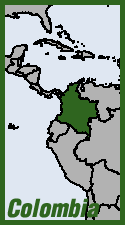 Colombia’s government and the FARC guerilla organization announced an agreement May 16, entitled "Solution to the Problem of Illicit Drugs," in which they pledge to work together agianst the narco trade. The FARC, whose top leaders face extradition to the United States on trafficking charges, agreed to "end any relationship" with the illicit drug trade, and cooperate in a "National Program for the substitution of the illicit uses of coca, poppy, and marijuana crops." The accord calls for "integral development plans" for rural communities impacted by the drug trade, to be drawn up with the participation of those communities, in the context of an "Integral Rural Reform." It also calls for an international conference to be held under the auspices of the UN to reconsider global strategies against drugs—the one veiled reference in the agreement to the FARC's earlier proposals to decriminalize cultivation of coca leaf and cannabis. "With this we will eliminate the gasoline that has fuelled the conflict in Colombia—drug trafficking," said the government's lead negotiator, Humberto de la Calle.
Colombia’s government and the FARC guerilla organization announced an agreement May 16, entitled "Solution to the Problem of Illicit Drugs," in which they pledge to work together agianst the narco trade. The FARC, whose top leaders face extradition to the United States on trafficking charges, agreed to "end any relationship" with the illicit drug trade, and cooperate in a "National Program for the substitution of the illicit uses of coca, poppy, and marijuana crops." The accord calls for "integral development plans" for rural communities impacted by the drug trade, to be drawn up with the participation of those communities, in the context of an "Integral Rural Reform." It also calls for an international conference to be held under the auspices of the UN to reconsider global strategies against drugs—the one veiled reference in the agreement to the FARC's earlier proposals to decriminalize cultivation of coca leaf and cannabis. "With this we will eliminate the gasoline that has fuelled the conflict in Colombia—drug trafficking," said the government's lead negotiator, Humberto de la Calle.
"Building a stable and lasting peace requires the willingness of all to contribute to the clarification between the conflict and the cultivation, production, and marketing of illicit drugs, and money laundering arising from this phenomenon, so that drug trafficking never again threatens the country's destiny,” the joint statement read.
The agreement on the drug trade concludes the third stage of a six-round peace process underway in Havana, Cuba. The previous agreements concerned agrarian reform and political participation; the remaining three rounds concern terms for a definitive ceasefire, restitution for victims, and protocols for implementation and verification. (The Economist, May 17; Colombia Reports, Comunicado Conjunto #36 via Presidencia de la República, Bogotá, May 16; ColombiaPeace.org, Nov. 15)
As the accord was announced, a conference was underway in Washington DC, entitled "Drug Trafficking and the Peace Process in Colombia," jointly sponsored by the Woodrow Wilson Center and the Fundación Ideas para la Paz, a Bogotá think-tank. Bruce Bagley, a University of Miami scholar who specializes in Latin American affairs, told the assembage that eradication efforts by the Bogotá government have forced Colombian cocaine production down—while production is rising in neighboring Peru. Today, the two Andean nations are roughly on par, he said, with each accounting for about 44% of world production and Bolivia accounting for the remainder. This is a turn-around from 2005, when Colombia grew an estimated 90% of the world's coca leaf.
"The FARC has been involved in cocaine trafficking since the early 1980s," Bagley said. "They've been able to use this as an important source of financing, and they continue to do so today. For them to give it up will be very tough. It's a question of life and death." He estimated that the FARC earns $300 million a year from the cocaine trade. (Tico Times, Costa Rica, May 17)
This is why efforts against the drug economy depend on the success of the accords on agrarian reform and political participation. Colombian gains against coca leaf in recent years as production rises in Peru merely reverse the situation of the 1990s, when gains in Peru pushed production into Colombia—an instance of the so-called "balloon effect." Contrary to the assumption that the drug trade itself is the "gasoline" that fuels the conflict, endemic poverty is both what forces peasants to grow dope to survive, and makes them angry enough to support a guerilla movement.
Cross-post to High Times







Recent comments
5 days 9 hours ago
4 weeks 3 days ago
8 weeks 4 days ago
9 weeks 2 days ago
19 weeks 2 days ago
23 weeks 2 days ago
24 weeks 3 days ago
24 weeks 3 days ago
45 weeks 3 days ago
49 weeks 4 days ago